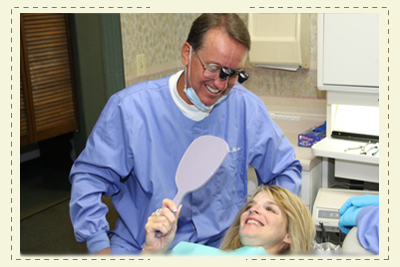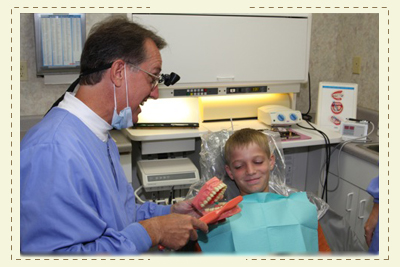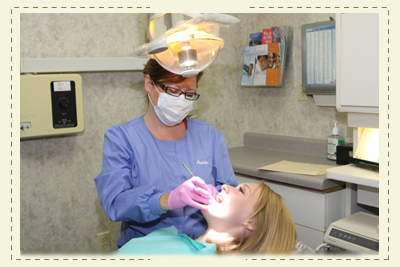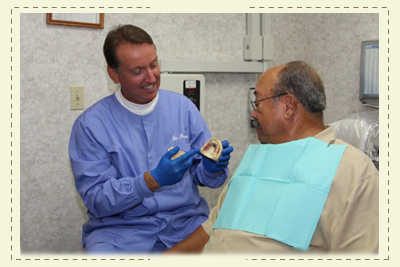SERVICES AND PROCEDURES
Silver Fillings
Silver dental restorations are a mixture of one of several metals (silver, copper, tin) and mercury. They have had a long and successful history in dentistry due to their value and durability. There are several detrimental factors to silver. They require a more aggressive tooth preparation than other restorative materials and are often sensitive to thermal stimulus for some time after placement. These fillings are grey or silver colored which is unacceptable to many patients especially given the tooth colored restorations that are available today. They also do not offer the tooth any support thus leading to potential future fracture of the teeth. Tooth fracture from silver fillings is something that I see often in my practice and for this reason I have chosen to use silver only in those situations where I have no other viable material option.
White Fillings

White or tooth colored fillings is becoming the standard direct dental restoration today. They are a blend of resin and a finely ground silicate quartz glass. They obviously are preferred by most patients due to their esthetics. There was a time when they did not wear as well as silver fillings but today this has been corrected. They also add bonded support to the tooth which results in less fractured or cracked teeth. This could prevent many future root canals, crowns, or extractions. These materials are very technique sensitive, in other words they are difficult to place and demand meticulous clinical techniques to be placed well. You will find that we really are attentive to detail in performing these procedures. These materials are advantageous because they are much less sensitive after placement than silver and they can be functioned on immediately. These materials are used to restore cavities, close gaps, and as veneers (facings).
Bleaching/Whitening
There has been so much interest in whitening teeth in the last several years. Bleaching involves placement of some type of chemical (typically buffered hydrogen peroxide) that is placed against the teeth. There are basically three levels of bleaching that can be used. Use of a "over-the-counter" preparations such as Crest White Strips. This uses the weakest and safest form of bleaching agent. This is the least expensive treatment.
Use of a "take home" bleaching system which is the primary form of bleaching that is done in our office. Impressions are taken of the teeth, models produced and bleaching trays are fabricated that hold the gel against the teeth. The trays are filled and applied by you sometime during your day. It is not recommended to wear them overnight. Application times are recommended every 2-3 days for 1-2 hours and this would last 2-3 weeks. These factors are all slightly variable based on differences between patients and their goals. This is the middle range in terms of pricing.
"In office" bleaching is typically done in a one hour appointment in the office. There are times when 2 visits are required. This is the most expensive form of bleaching treatment.
We would be happy to discuss these options with you in a consultation appointment in our office. We have almost 20 years experience with bleaching and have a lot of insight and experience to share with you on what would be the best selection for your bleaching needs.
Porcelain Veneers
Porcelain veneers are ultra thin shells of ceramic material, which are bonded to the front of teeth. This procedure can be the ideal choice of improving the appearance of the front teeth. Porcelain veneers are placed to mask discoloration, to brighten teeth, and to improve the smile. Highly resistant to permanent staining from coffee, tea, or even cigarette smoking, the wafer-thin porcelain veneers can achieve a tenacious bond to the tooth. Their esthetically pleasing naturalness is unsurpassed by other restorative options. They are a treatment option that is very conservative with amount of tooth preparation needed. These restorations will require 2-3 appointments. Generally there is an appointment for tooth preparation, impressions, and photographs. A dental laboratory will take this information and fabricate the veneer restoration for seating at subsequent appointments. There has been a lot of interest in Lumineers (trademark) recently. This is one type of veneer that is very thin. It is one of a host of different types and thicknesses of veneers that are selected depending on your dentition.
Direct Composite Veneers

Direct composite veneers are similar to porcelain veneers except composite resin is used instead of laboratory fabricated porcelain. This is a procedure that is done in one appointment and can have dramatic effects on your smile. It is less than half the cost of porcelain veneers and can give you that smile that you have been wanting for a much more affordable price. It is generally thought that these materials will last 8-10 years but I have seen it last much longer than this.
Crowns
A crown is a restoration that covers or "caps" a tooth to restore it to its normal shape and size, strengthening and improving the appearance of a tooth. Crowns are necessary when a tooth is generally broken down and fillings won't solve the problem. If a tooth is cracked, a crown can hold the tooth together to seal the cracks so the damage does not get worse. Crowns are also used to attach a bridge (replacement for missing teeth), restore fractured teeth, or cover badly shaped or discolored teeth. A wide variety of materials are used including porcelains and gold restorations. Selection of a material will depend on your esthetic and functional needs.
Generally crowns are placed in 2 appointments. Initially the tooth is prepared or reduced so the crown can fit over it. Impressions are made for the dental laboratory to make the crown. A temporary crown is placed until the permanent crown is made. On the second visit the dentist will remove the temporary crown and fit and cement the permanent crown onto the tooth.
Dental Hygiene - Plaque

Research has shown that controlling plaque is important in the control of decay and gum disease. Plaque is neither food or food residue. It is a sticky, clear deposit of bacteria that adheres to the surface of teeth and gum tissue. There are different types of bacteria that make up plaque and there are several responses to their presence: teeth can decay, calculus (tartar) can form, and gum tissues can become inflamed (gingivitis). Plaque is very adherent and requires mechanical removal by flossing or brushing or a dental prophylaxis. Using a mouth rinse alone will not remove plaque. Plaque begins forming on teeth just several hours after brushing. The rate at which plaque forms varies between individuals and locations in the mouth. Plaque will accumulate most rapidly at the gum line.
Calculus (tartar)
Plaque which is not removed regularly by brushing and flossing can harden into calculus which is very crusty and mineralized. This deposit can only be removed by a dentist or dental hygienist. These deposits can be above the gum line or below the gum line. They are a significant factor in periodontal disease because of the localized bacterial infection and the roughness of the plaque. Thorough regular removal of these deposits is critical to reduce the onset of periodontal disease or slow it's progress. Formation of calculus varies by several factors, genetic, dietary, saliva, and bacterial flora. It is recommended that most patients have a dental cleaning every 6 months or more frequently to remove these deposits.
Recall and Maintenance

You should visit your dentist at least every six months or more frequently to get your teeth cleaned and examined. By seeing the dentist twice a year, we can monitor your oral health and help you prevent any problems that may arise before they become uncomfortable or require more comprehensive or expensive treatment. We may suggest more frequent or less frequent visits depending on your oral condition.
Sealants
A sealant is a resin coating that is placed in the grooves of the chewing surfaces of the posterior or back teeth. This is done to prevent food particles and bacteria from getting into these grooves thus preventing tooth decay in this area. In our office we will painlessly clean the grooves with a rotary diamond. This results in a much more effective and long lasting sealant. Sealants will easily last 5-10 years.
Most sealants are done on permanent molars in children or teenagers because of poor diet and high susceptibility to decay although any tooth may have reason to be sealed. These are truly a highly effective, inexpensive, and painless way to prevent dental decay and future structural breakage of teeth. They are a real value and are so easy to place.
Dentures
In the unfortunate situation where you have lost all of your upper and/ or lower dentition, replacement of your teeth can be accomplished by the fabrication of dentures. Dentures are made by attaching either plastic or porcelain teeth in a pink plastic base that rests against the gum tissue. Information for the new denture wearer can be found at http://www.ada.org/public/topics/dentures_faq.asp. It takes time to adjust to wearing dentures and it is normal for sore spots to develop. We would ask that you wear your dentures at least several hours before your adjustment visit so that we can visualize the sore in the mouth.
Immediate Dentures
These are dentures that are fabricated for immediate placement at the time of extraction of the remaining teeth in the mouth. This is the selection of choice when the patient requires a replacement of teeth at the same time the natural teeth are extracted. Normal dentures require the oral tissues to be healed for approximately 4-6 weeks following extractions before impressions are taken. Immediate dentures typically need to be relined or replaced with a new set of dentures 3-6 months after placement. This occurs because the surgically treated oral tissues will shrink away from the denture bases causing loose or ill fitting dentures.
Partial Denture

A partial denture is fabricated to replace several missing teeth in the dental arch. These prosthetics are considered a good restorative value because their cost is so much less than other dental restorations. They are often used in applications where there are more missing teeth than can be economically replaced with fixed crowns, bridges, or implants. Usually they can be made in less time and are less invasive than other restorative options. Partial dentures are removable and it is suggested that they be left out when sleeping. They are typically made from plastic, metal, or a combination of both materials.
Root Canal Therapy
Underneath your tooth's outer enamel and within the dentin is an area of soft tissue called the pulp, which carries the tooth's nerves, blood vessels and connective tissue. Root canals are very small, thin divisions that branch off from the top pulp chamber down to the tip of the root. A tooth typically has from 1-4 canals.
When the pulp becomes infected due to a deep cavity or fracture that allows bacteria to seep in, or injury due to trauma, it can die. Pain in the tooth is commonly felt when biting down, chewing on it and applying hot and cold food and drinks.
Root canal therapy is necessary because the tooth will not heal by itself. Without treatment the infection will spread from the tooth to the surrounding bone and can lead to loss of the tooth and potentially be deleterious to your health. This condition is known as a dental abscess.
A root canal is a procedure done to save the damaged or dead pulp in the root canal of the tooth by cleaning out the diseased pulp and reshaping the canal. The canal is filled with a rubber like substance called gutta-percha to prevent recontamination of the tooth. The tooth is then restored with a bonded restoration, a post, or some type of crown or onlay. Root canals generally take from 1-3 appointments depending on the level of difficulty of the specific tooth or level of disease present.
DIAGNOdent
 DIAGNOdent Accurate, reliable, caries detection aid. More and more patients place value on healthy attractive teeth. In order to maintain them, the earliest possible care is essential.
DIAGNOdent Accurate, reliable, caries detection aid. More and more patients place value on healthy attractive teeth. In order to maintain them, the earliest possible care is essential.
DIAGNOdent aides in the detection of caries. Even very small lesions are detected at the earliest stage, enabling you to protect and preserve the tooth substance.


 Official team Dentist of the Burlingotn Bees
Official team Dentist of the Burlingotn Bees
 Official team Dentist of the SCC Blackhawks
Official team Dentist of the SCC Blackhawks
